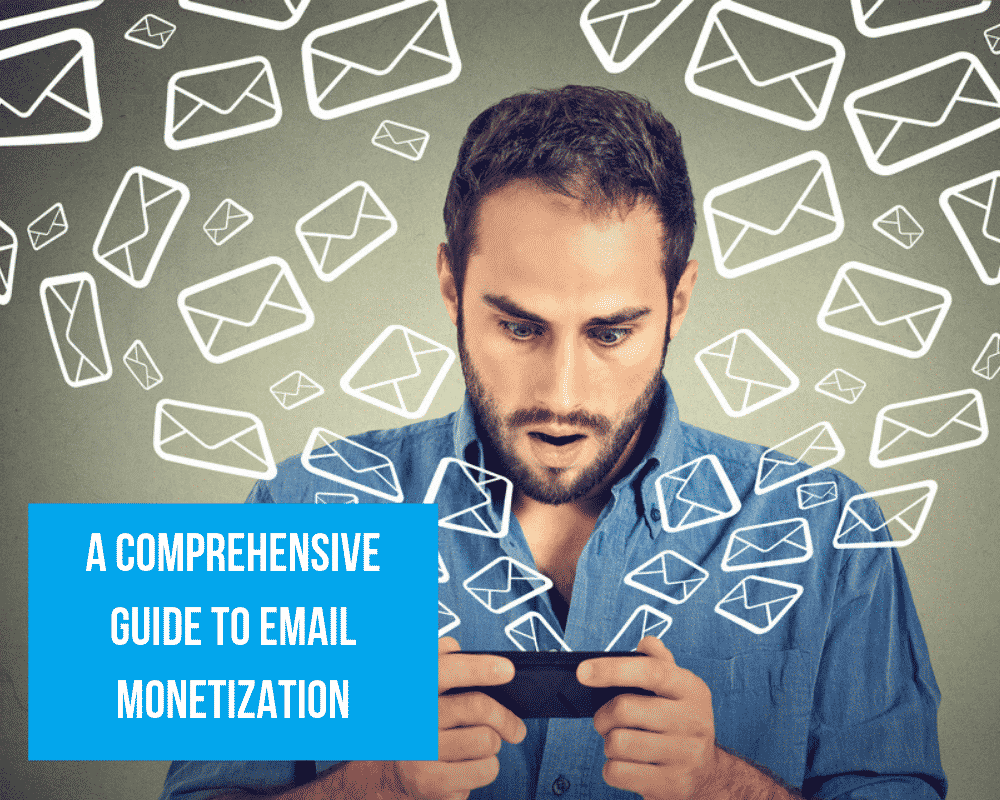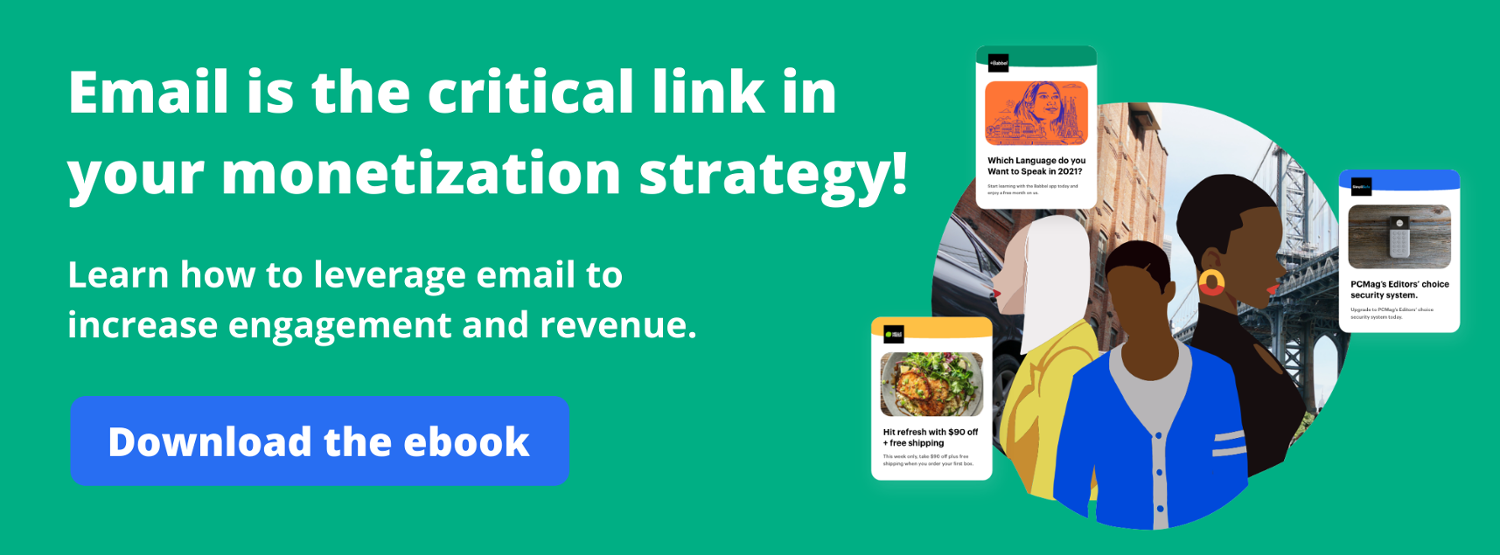More than half of all adults — 60 percent of them — subscribe to at least one email newsletter. And if the size of the audience isn’t enough to convince you that email marketing is valuable, consider the ROI.
Email marketing drives robust return — as much as $38 or more for every dollar you spend on it.
Yes, that’s a 3,800 percent return. And no, it’s not a typo. Email advertising really can be that powerful (and cost-effective).
But you can drive up the value of your email marketing lists even more by monetizing it directly. Here’s what you need to know.
What Is Email Monetization?
Technically, email monetization occurs whenever you use your email marketing list for any type of revenue-generating efforts. Most people usually differentiate between basic email marketing and direct monetization.
Email marketing occurs when you build a list of subscribers and send them newsletters or drip campaigns with the ultimate goal of getting them interested in your products. This is true whether you’re actually hawking your wares directly in an email (such as offering a link to a product page) or you’re building a relationship with your audience by offering relevant and useful articles or tips.
The goals of email marketing can include building brand awareness, driving traffic to your site and making sales, so it is monetization in some ways.
However, for the purposes of this guide, email monetization refers to any activities above and beyond marketing that you use your email for in order to make money. Some examples include:
“Renting” your list or writing sponsored emails. This occurs when you send a message on behalf of another brand to your subscriber base and charge the brand for the opportunity. Note that this is very different from selling your list. Selling your list occurs when you provide a list of all your email subscribers to a third party in exchange for money; that third party then uses the list to send unsolicited sales emails or sells the list repeatedly to spammers. This is not something you want to do. It could cross legal lines, and it definitely alienates your subscribers.
Now that GDPR privacy regulations have been put in place, businesses that handle personal data must stay in compliance with this new Data Protection Act, and provide safeguards to protect their subscriber’s data to avoid any lawsuits.
Email advertising. This occurs when you include ads within your emails. You can work directly with advertisers, charging them for the opportunity to place ads before your subscribers, or with third-party ad sites, which automate the process of matching ads from many advertisers with your audience. Email ads can take several forms, including:
- Banner ads, typically displayed in the header or footer of your emails
- Button or image ads, which can be placed throughout the email
- Native or text ads, which appear as links within the copy of the email
When You Should Use Ads in Emails and When to Avoid Them
Many email marketing list owners automatically think monetization outside of their own marketing and branding efforts is a bad idea. Here are some email monetization myths driving that thought process and some facts that shed a more positive light on email monetization.
Myth: Ads split my audience, which means fewer sales for me.
Okay, this might be true if you include ads for your direct competitors. But obviously, you’re going to set up email monetization to avoid that. If you’re including ads for noncompeting products that are truly interesting and relevant to your audience, then your email readers are more likely to see this as helpful (or at least definitely not harmful). And buying a product via one of the ads doesn’t mean they aren’t going to buy yours.
Myth: No one ever clicks on email links or ads.
The numbers show this one is just wrong. In fact, a whopping 70 percent of Gen Zers will click through on email ads that are relevant to them. And older audiences are also likely to click: more than half of baby boomers (57 percent) say they will too.
Myth: Ads annoy your email subscribers.
Admittedly, there’s some truth to this one. Spammy ad content in your email — pretty much anything that reduces user experience by cluttering the page, confusing the reader or making the email slow to load — is annoying. But many people don’t mind ads that are tastefully included, especially when they’re relevant. More than half of all people in a Mantis Research study said ads didn’t bother them, and 62 percent of millennials said they either didn’t even notice advertisements or weren’t bothered by them in email.
The TL;DR on When to Use Ads in Email Marketing Campaigns
The answer is to include advertising in emails when:
- You can incorporate relevant and helpful advertising that resonates with your target audience.
- It won’t impact the functionality of your email.
- You can do so in a tasteful manner that doesn’t look or feel like spam.
- Your list is made up of younger audiences, which are highly tolerant of ads in emails
You should not include advertising in emails when:
- You haven’t built an audience or trust with your audience yet.
- Your subscriber list numbers are trending down and you can’t figure out why ads in email newsletters work best when you have a loyal stable of subscribers).
- You can’t guarantee that ads won’t be in direct contrast to the mission or vision of your brand or offensive to your readers.
When You Should Write or Allow Sponsored Content
Sponsored content is definitely the salt of email monetization: You don’t want more than a pinch here and there. Your subscribers didn’t sign up to your list to hear constantly from other brands; they want to hear from and about you. So, keep sponsored content:
- Minimal to increase its impact and reduce the chance that people get tired of all the recommendations or advertising.
- Highly relevant — sponsor content when you truly feel a product, service or brand is something your audience is going to get excited about or goes hand-in-hand with your own.
- True to your brand, so that it never looks like you allowed another company to take over your list; the content can be about another brand’s product, but it should still sound like it’s coming from you.
How Does Email Advertising Work?
The basic premise of email advertising is this: You build a viable list of subscribers interested in your content. You then include sponsored content, links or ads in emails you send to those individuals. When subscribers click through on those ads or make purchases via your links, you are compensated. In some cases, you may be paid simply for the placement of an ad or sponsored content.
Here are some common steps required to monetize your email content correctly.
1. Build a list. While you can opt into PPC ad programs as a publisher with only a couple of subscribers, this is not typically the best option. While Mantis Research’s survey does show people are surprisingly tolerant of email ads, those answers probably assume a few things: the user already appreciates and trusts the brand’s content, and the ads are relevant and add to the overall experience (or at least don’t detract from it).
2. Decide on an email monetization plan. Answer questions that include:
- How many ads will you include or how often will you send sponsored content?
- What types of ads are you comfortable displaying?
- How much will you charge for sponsored content? Sponsored content is a little more personal. You may want to reach out to brands you already like that have a potential connection with your audience, and they’ll want to know:
-
- How many subscribers do you have?
- What are your typical email open rates?
- How much you charge per subscriber or open rate (typically, you can charge more for exposure to bigger lists or if you have a very targeted, niche-based list with high open rates — advertisers are willing to pay for quality).
3. Connect with a third party for advertising. Seeking out individual advertisers, negotiating contracts and managing the ad process is honestly too time-consuming for most list owners to manage. The cost of manually managing your email ad processes could wipe out any value you build by monetizing. Instead, consider working with a third party such as Jeeng. Some benefits include:
- Dynamic content in 175 categories to better ensure ads are relevant to your audience.
- Hyper-targeted content that helps you continue to build subscriber trust and loyalty while increasing ROI.
- Tracking that lets you view trends and make data-backed decisions about email ad efforts.
Various third parties have slightly different procedures, but here’s how automated email triggers work when you partner with Jeeng:
- You set up your account and launch an ad campaign.
- When a subscriber opens one or your emails with a Jeeng ad Fpucampaign, a request goes to the Jeeng server.
- The server uses the subscriber’s email (and its associated web history) in conjunction with your ad settings to choose an ad to display. This is all handled automatically in microseconds.
- A targeted ad is displayed to the user.
How Many Subscribers do you Need to Make Money
In the US alone, 20% of the total advertising revenue for publishers is from placing ads in emails. There isn’t any real straightforward answer when it comes to how many subscribers you need to make money, though. It depends on the tools you use. You could, in theory, make money from a smaller number of email subscribers. For example, if you work with Jeeng, you could technically make money from just 1 subscriber since we work on a rev share. But obviously, the more email subscribers you have, the more money you will earn.
What Publishers Need to Know About Testing Email Ads
Launching ads in email newsletters really is that easy. Jeeng handles a lot of the work for you. At time of set-up, you should test campaigns, review open rates, click-throughs, and other metrics. Make tweaks to find what works best for you and your audience.




